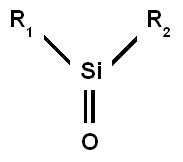
A silanone in chemistry is the silicon analogue of a ketone. The general description for this class of organic compounds is R1R2Si=O, with silicon connected to a terminal oxygen atom via a double bond and also with two organic residues (R).[1] Silanones are extremely reactive[1] and until 2013 were only detected by argon matrix isolation[2][3] or in the gas phase[4] but not isolated. A synthesis of a stable silanone was reported in 2014. Silanones are of some interest to academic research, with their reactivity being of some relevance to the double bond rule.
Silanones are unstable and favor oligomerisation to siloxanes. The reason for this instability is the weak pi bond with a small HOMO–LUMO energy gap caused by an unfavorable overlap between the p-orbitals of silicon and oxygen. A second reason for the observed instability is the strongly polarized silicon–oxygen bond, Siδ+–Oδ−.[1]
History
The first to postulate a silanone were Kipping & Lloyd in 1901,[5] but their products were in fact siloxanes. It was not until 2014 that a stable silanone was reported.[6] In this compound, silicon is bonded to a SIDipp (1,3-bis(2,6-iPr2-C6H3)imidazolidin-2-ylidene) group and a (Cp*)Cr(CO)3 group. Its stability is owed to the direct coordination of silicon to chromium and to steric shielding. The reported Si=O bond length is 1.526 Å, in line with expectations. It has been described as a cationic metallosilanone.[1]
Other strategies have recently been used to stabilise silanones,[7] for example coordination to Lewis acids or bases[8] and steric shielding.[9]
References
- ^ a b c d Sen, S. S. (2014). "A Stable Silanone with a Three-Coordinate Silicon Atom: A Century-Long Wait is Over". Angew. Chem. Int. Ed. 53 (34): 8820–8822. doi:10.1002/anie.201404793. PMID 24990653.
- ^ On the proposed thermal interconversion of matrix-isolated dimethylsilylene and 1-methylsilene: their reactions with oxygen atom donors Charles A. Arrington, Robert West, Josef Michl J. Am. Chem. Soc., 1983, 105 (19), pp 6176–6177 doi:10.1021/ja00357a048
- ^ Infrared spectroscopic evidence for silicon-oxygen double bonds: silanone and the silanoic and silicic acid molecules Robert Withnall, Lester Andrews J. Am. Chem. Soc., 1985, 107 (8), pp 2567–2568 doi:10.1021/ja00294a070
- ^ M. Bogey; B. Delcroix; A. Walters; J-C Guillemin (1996). "Experimentally Determined Structure of H2SiO by Rotational Spectroscopy and Isotopic Substitution". J. Mol. Spectrosc. 175 (2): 421–428. Bibcode:1996JMoSp.175..421B. doi:10.1006/jmsp.1996.0048.
- ^ XLVII.—Organic derivatives of silicon. Triphenylsilicol and alkyloxysilicon chlorides F. Stanley Kipping, Ph.D., D.Sc., F.R.S. and Lorenzo L. Lloyd J. Chem. Soc., Trans., 1901,79, 449-459 doi:10.1039/CT9017900449
- ^ Filippou, A. C., Baars, B., Chernov, O., Lebedev, Y. N. and Schnakenburg, G. (2014), Silicon–Oxygen Double Bonds: A Stable Silanone with a Trigonal-Planar Coordinated Silicon Center. Angew. Chem. Int. Ed., 53: 565–570. doi:10.1002/anie.201308433
- ^ Xiong, Y.; Yao, S.; Driess, M. (2013). "Chemical Tricks To Stabilize Silanones and Their Heavier Homologues with EO Bonds (E=Si–Pb): From Elusive Species to Isolable Building Blocks". Angew. Chem. Int. Ed. 52 (16): 4302–4311. doi:10.1002/anie.201209766. PMID 23450830.
- ^ Sun, T.; Li, J.; Wang, H. (2022). "Recent Advances in the Chemistry of Heavier Group 14 Analogues of Carbonyls". Chem. Asian J. 17 (18): e202200611. doi:10.1002/asia.202200611. PMID 35883252. S2CID 251104394.
- ^ Kobayashi, Ryo; Ishida, Shintaro; Iwamoto, Takeaki (2019). "An Isolable Silicon Analogue of a Ketone that Contains an Unperturbed Si=O Double Bond". Angew. Chem. Int. Ed. 58 (28): 9425–9428. doi:10.1002/anie.201905198. PMID 31095845. S2CID 157056381.
